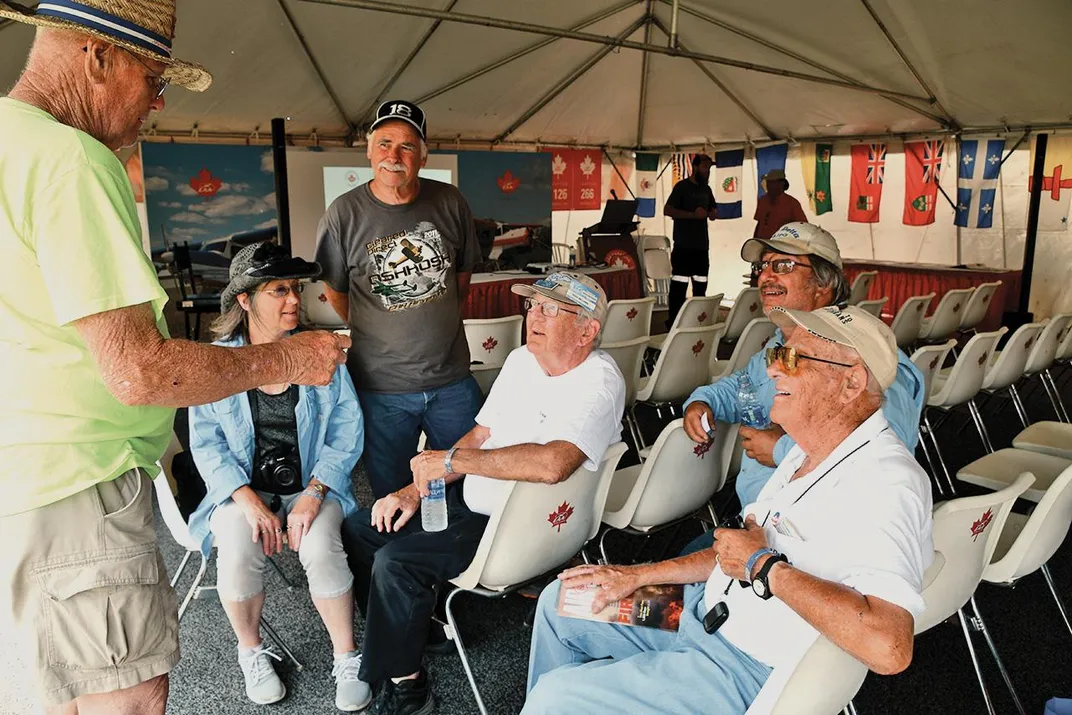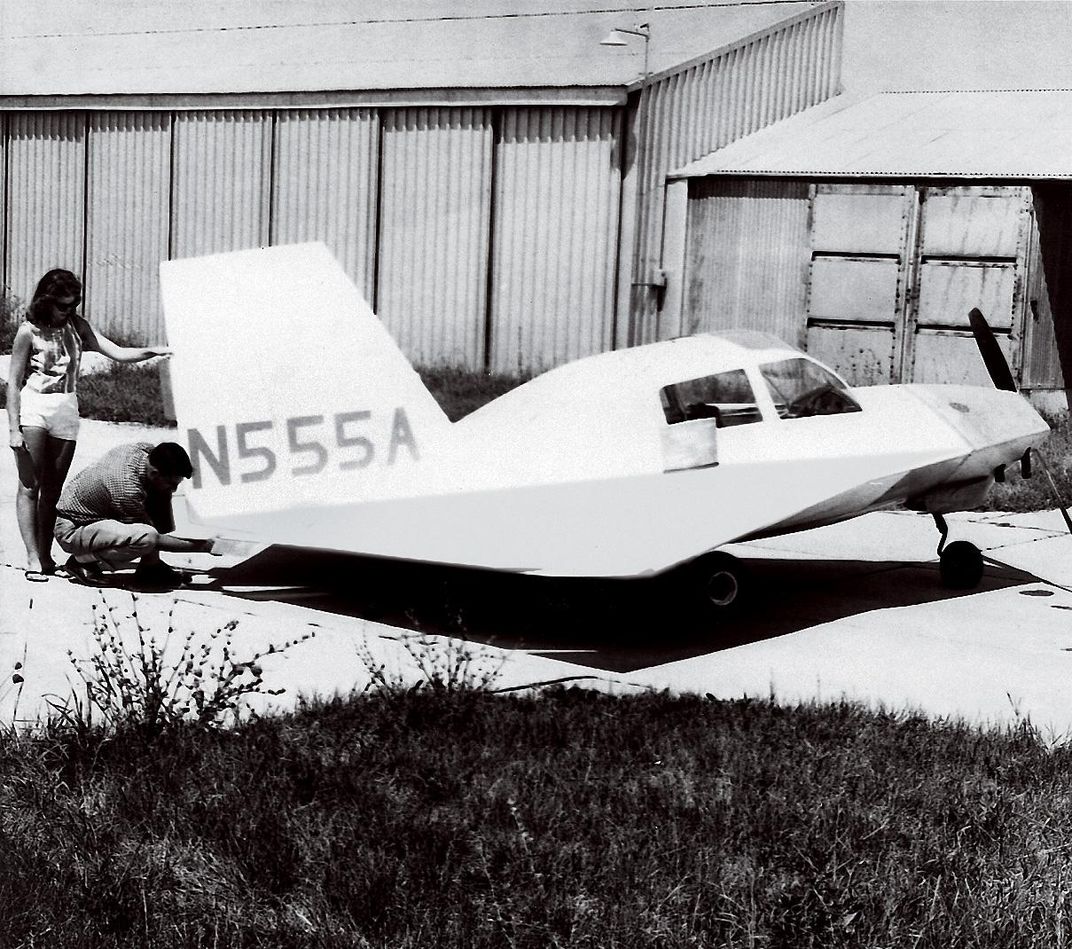Some Homebuilt Airplanes Create a Movement. This One Created a Family.
John Dyke knew exactly the kind of airplane he wanted. Turns out dozens of pilots wanted the same thing.
:focal(2035x1048:2036x1049)/https://tf-cmsv2-smithsonianmag-media.s3.amazonaws.com/filer/8b/72/8b72ea6e-4cf9-4fad-b58c-dbc5094ba725/08-2d_as2021_dykedeltahomebuilt_dykedeltan18dw_0013_live.jpg)
Parked together on the grass at the Experimental Aircraft Association’s (EAA) aviation extravaganza in Oshkosh, Wisconsin, the five strange airplanes look as if they might have flown in from the future. The Dyke Delta has no horizontal tail and the body is almost all wing—a very space-age, stealthy airplane.
On the porch of a nearby cafe, a group of 25 or 30 people cluster around an older gentleman. The annual Dyke Delta “family reunion” is in session, designer John W. Dyke presiding. Despite the ultramodern appearance of the Delta, it’s been 50 years since Dyke put the first lines of the airplane on paper.
His family of aviation enthusiasts has grown since then. “I know every Delta builder by name, and I know all their stories,” says Dyke. One of the earliest additions to that family, Al White, a pilot in Superior, Wisconsin, started construction in 1971. He had intended the airplane as transportation for his family of four. It didn’t work out that way. By the time he flew his JD-2 in 2010, some 39 years after making the first parts, his son and daughter had families of their own.
Despite the prolonged construction period, White is happy he spent the time. “It’s a great cross-country mount,” he says. “It’s very stable, easy to fly, and cruises at 165 knots. It lands quite nose-high, but not all that fast. In the airport landing pattern, it’s easy to fly at 85 knots, which is similar to most small airplanes. I’ve taken a lot of kids for rides through the EAA’s Young Eagles program. They love flying in the ‘spaceship.’ It’s exciting to bring it to Oshkosh and be part of the reunion.”

Not many people design their own airplanes, but John Dyke had a specific set of requirements: He wanted much better performance than the garden-variety Cessnas and Pipers could provide, and he wanted an airplane that would carry his family of four (at the time) in an era when homebuilt designs were usually single-seat sportsters. The unheated, uninsulated metal hangars at his local Ohio airport were pretty awful places during the winter. They were expensive too. So, he wanted an airplane he could keep and maintain in his comfortable garage and take to the airport easily when he wanted to fly.
The more he read and researched, the more he thought the solution might lie in the work of German engineer Alexander Lippisch. Between the wars, Lippisch was a proponent of compact tailless aircraft, seeing them as a way to increase performance as well as being easier to build—with fewer surfaces exposed to the air, there would be less drag, and, of course, there would be fewer parts, making the airplane cheaper and lighter. Lippisch constructed several gliders to test his ideas, which eventually resolved into a small aircraft with a triangular wing and no horizontal tail. During World War II, his ideas inspired the Messerschmitt Me 163 Komet, a rocket-powered interceptor with no horizontal tail. The Komet saw limited service, but most of Lippisch’s innovative designs remained on paper.
/https://tf-cmsv2-smithsonianmag-media.s3.amazonaws.com/filer/53/10/5310a945-cbdd-4ed2-b386-28db2f988f5b/08-2c_as2021_dykedeltahomebuilt_garryjimworkingjd-2_live.jpg)
In 1954, Dyke was in the Navy, serving in the Mediterranean. “When I got some leave, I traveled to Germany,” Dyke remembers. “I found the library containing Lippisch’s data and began working to understand his ideas.” When back in the United States, Dyke began working as an aircraft technician at the Wright-Patterson Air Force Base in 1956, where captured Axis aircraft had been sent for evaluation (including a Lippisch-designed, delta-wing glider). The base library was full of pilot reports and technical papers.
Immersed in a sea of ideas, Dyke began his own experiments in 1959, starting with scale models. In 1962, he completed a full-size aircraft, the Dyke Delta JD-1. It was a “double-delta” configuration with what would now be called chines extending from the front of the cowl, spreading as they went aft and eventually joining a trapezoidal wing that extended to the very rear of the airplane. There was no conventional fuselage—the entire airplane was one big airfoil. There was a vertical fin but no horizontal tail. Hinges sprouted vertically from the “wingroots,” or at the point where the wings blended into the fuselage. These mounted hinges enable the wings to fold across the top of the cabin so the airplane can be towed on its own wheels behind a car. First flown in 1962, the JD-1 was well on the way to proving Dyke’s ideas. “I was very pleased when the data derived from the models and test rigs agreed to within about five percent with data gathered in the actual airplane,” he says.
Lippisch himself had come to the United States, eventually ending up in Iowa. Dyke was finally able to meet Lippisch in person at the 1962 Experimental Aircraft Association Fly-in Convention in Rockford, Illinois—two weeks after the first test flights of the Dyke Delta JD-1. Then, Lippisch and Dyke met again at the same venue in 1963 and 1964.
But, in June 1964, the JD-1 was destroyed in a fire caused by a welding accident. With the encouragement of his wife Jennie, Dyke decided to rebuild the aircraft. What eventually emerged from the Dyke garage in 1966 was an essentially new design—bigger, better-equipped, and more powerful. Seats had been increased from three to four, but not in the usual two-in-front, two-in-back arrangement. Instead, the pilot sat in lonely splendor up front on the centerline while three people sat on a cabin-wide bench seat in the back. Dyke designated it the JD-2.

When the JD-2 premiered at the EAA Fly-in in Rockford in 1966, it attracted quite a crowd. But it was soon apparent that a Delta was not a project for the easily discouraged. Dyke had full construction plans that would allow a skilled craftsman to replicate the airplane, but decided that he had no interest in getting into the kit business. Anybody building a Delta would have to build every part of it. In the 1968 issue of Sport Aviation, Dyke noted that “about 40 Deltas were being built” and that he and Jennie had answered “over 1,500 letters in 16 months.”
Like Al White, Garry Kingma brought his JD-2 to the 50th celebration at Oshkosh. A Canadian tool-and-die maker, Kingma was in the market for a fast family airplane when he saw an article on the Delta and decided he had to have one too. “It was a long haul,” he remembers. “I put about 4,000 hours into construction. It certainly wasn’t like building a modern kit airplane. Sometimes I had to make the tools to make the parts. But the airplane does what I wanted to do, and it’s introduced me to an extended family of people who are interested in the Delta.”
Jim Maher knows all about that family. When he first became interested in the Delta, he visited Bernie Schaknowski in Syracuse, New York. (The author’s first ride in a homebuilt airplane was with Schaknowski in his Delta.) “We were strangers, but because I was a Delta enthusiast, he and his wife welcomed me with open arms,” Maher says. “They spent most of the day answering my relentless questions about his Delta. By the end of the day we were good friends. I remember thinking, ‘If this was the caliber of people involved with this aircraft, I wanted to be a part of it.’ Later, when I was actually building, Kingma and his family drove the 1,200-mile round trip from their home in Canada to visit and encourage me.”
Today, an estimated 50 Dyke Deltas have been built, but something less than a dozen fly regularly. Those that do bring a lot of satisfaction to their pilots—they travel fast, handle well, and look like nothing else in the sky. And like many of their builders hoped, they have proved to be good family airplanes, in more ways than one.
Ken Scott builds, flies, and writes about airplanes from his home in a northwestern Oregon airpark.